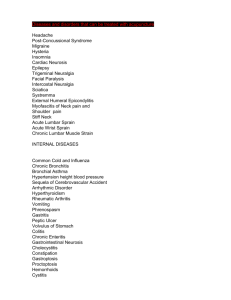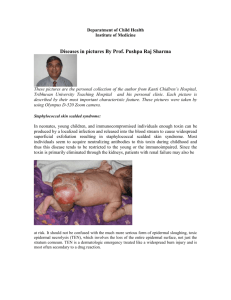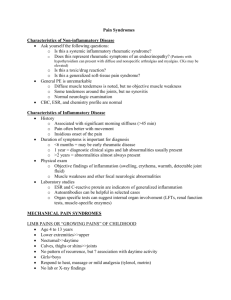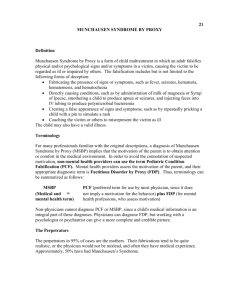Blood and Lymph Diseases
advertisement
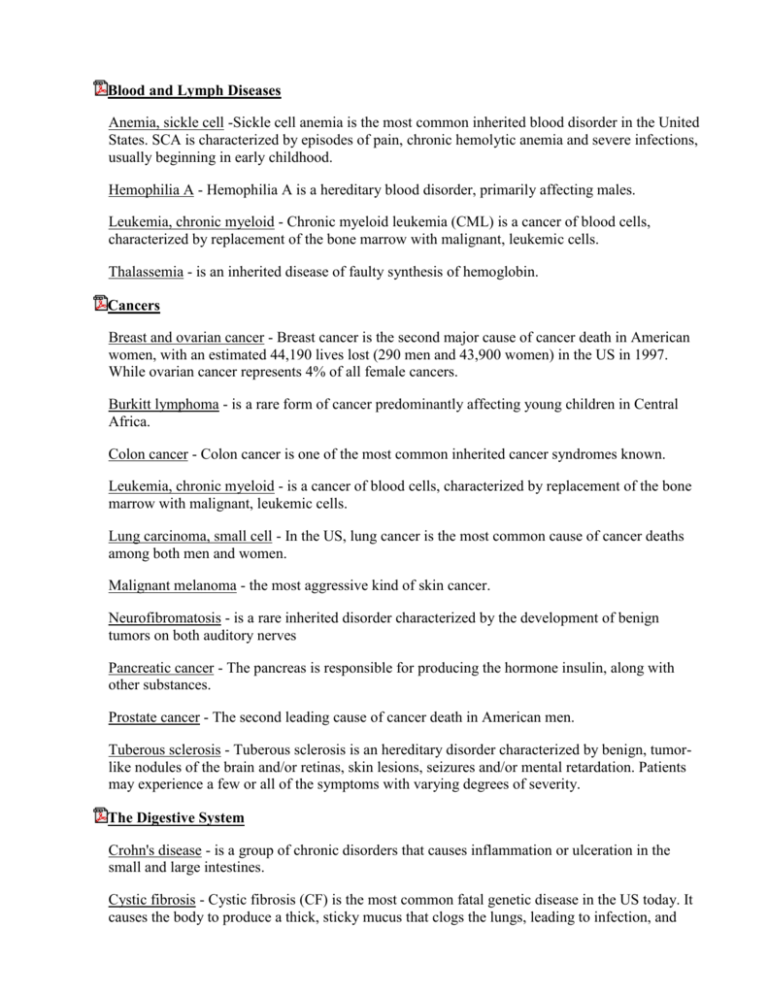
Blood and Lymph Diseases Anemia, sickle cell -Sickle cell anemia is the most common inherited blood disorder in the United States. SCA is characterized by episodes of pain, chronic hemolytic anemia and severe infections, usually beginning in early childhood. Hemophilia A - Hemophilia A is a hereditary blood disorder, primarily affecting males. Leukemia, chronic myeloid - Chronic myeloid leukemia (CML) is a cancer of blood cells, characterized by replacement of the bone marrow with malignant, leukemic cells. Thalassemia - is an inherited disease of faulty synthesis of hemoglobin. Cancers Breast and ovarian cancer - Breast cancer is the second major cause of cancer death in American women, with an estimated 44,190 lives lost (290 men and 43,900 women) in the US in 1997. While ovarian cancer represents 4% of all female cancers. Burkitt lymphoma - is a rare form of cancer predominantly affecting young children in Central Africa. Colon cancer - Colon cancer is one of the most common inherited cancer syndromes known. Leukemia, chronic myeloid - is a cancer of blood cells, characterized by replacement of the bone marrow with malignant, leukemic cells. Lung carcinoma, small cell - In the US, lung cancer is the most common cause of cancer deaths among both men and women. Malignant melanoma - the most aggressive kind of skin cancer. Neurofibromatosis - is a rare inherited disorder characterized by the development of benign tumors on both auditory nerves Pancreatic cancer - The pancreas is responsible for producing the hormone insulin, along with other substances. Prostate cancer - The second leading cause of cancer death in American men. Tuberous sclerosis - Tuberous sclerosis is an hereditary disorder characterized by benign, tumorlike nodules of the brain and/or retinas, skin lesions, seizures and/or mental retardation. Patients may experience a few or all of the symptoms with varying degrees of severity. The Digestive System Crohn's disease - is a group of chronic disorders that causes inflammation or ulceration in the small and large intestines. Cystic fibrosis - Cystic fibrosis (CF) is the most common fatal genetic disease in the US today. It causes the body to produce a thick, sticky mucus that clogs the lungs, leading to infection, and blocks the pancreas, stopping digestive enzymes from reaching the intestines where they are required to digest food. Diabetes, type 1 - is a chronic metabolic disorder that adversely affects the body's ability to manufacture and use insulin, a hormone necessary for the conversion of food into energy. The disease greatly increases the risk of blindness, heart disease, kidney failure, neurological disease, and other conditions Glucose galactose malabsorption - is a rare metabolic disorder caused by a defect in glucose and galactose transport across the intestinal lining. GGM is characterized by severe diarrhea and dehydration as early as the first day of life and can result in rapid death . Ear, Nose, and Throat Deafness Diseases of the Eye Glaucoma - Glaucoma" is a term used for a group of diseases that can lead to damage to the eye's optic nerve and result in blindness. Retinoblastoma - tumor develops from the immature retina - the part of the eye responsible for detecting light and color. Female-Specific Diseases Rett syndrome - begin to lose purposeful use of their hands and speech. Affected individuals also show reduced muscle tone, wringing hand movements, autistic-like behavior and seizures. Turner Syndrome – females with only one X chromosome Triple X syndrome - affects females only, they have three X chromosomes Glands and Hormones Adrenal hyperplasia, congenital - affects the adrenal glands. The production of several important hormones is blocked. Adrenoleukodystrophy - the fatty covering (myelin sheath) on nerve fibers in the brain is lost, and the adrenal gland degenerates, leading to progressive neurological disability and death. Breast and ovarian cancer Cockayne syndrome - people are sensitive to sunlight, have short stature, and have the appearance of premature aging. Diastrophic dysplasia - patients are usually short, have club feet, and have malformed hands and joints. PKU (phenylketonuria) – disorder of the body chemistry and if left untreated causes mental retardation. The Heart and Blood Vessels Ataxia telangiectasia - a progressive, degenerative disease characterized by cerebellar degeneration, immunodeficiency, radiosensitivity (sensitivity to radiant energy, such as x-ray), and a predisposition to cancer. Atherosclerosis - characterized by a narrowing of the arteries caused by cholesterol-rich plaques of immune system cells. Von Hippel-Lindau syndrome - abnormal growth of blood vessels Williams syndrome - "elfin-like" facial features, heart and blood vessel problems, irritability during infancy, dental and kidney abnormalities, hyperacusis (sensitive hearing) and musculoskeletal problems. Diseases of the Immune System Asthma - It is a chronic inflammatory disorder of the airways characterized by coughing, shortness of breath, and chest tightness. Severe combined immunodeficiency - little or no immune response Male-Specific Diseases Klinefelter Syndrome – boys with two X chromosomes and one Y chromosome. Male pattern baldness SRY: Sex determination - SRY (which stands for sex-determining region Y gene Muscle and Bone Achondroplasia - dwarfism Diastrophic dysplasia - patients are usually short, have club feet, and have malformed hands and joints Duchenne muscular dystrophy - muscle degeneration Ellis-van Creveld syndrome - dwarfism, polydactyly (additional fingers or toes), Fibrodysplasia ossificans progressiva - causes muscle to be turned into bone. Marfan syndrome - characterized by unusually long limbs, and is believed to have affected Abraham Lincoln. Osteogenesis Imperfecta – brittle bone disease Progeria - a rare condition characterized by an appearance of accelerated aging. Neonatal Diseases Angelman syndrome - characterized by mental retardation, abnormal gait, speech impairment, seizures, and an inappropriate happy demeanor that includes frequent laughing, smiling, and excitability. Cystic fibrosis Fragile X syndrome - most common inherited form of mental retardation Prader-Willi syndrome - characterized by mental retardation, decreased muscle tone, short stature, emotional lability and an insatiable appetite which can lead to life-threatening obesity. Waardenburg syndrome - a wide bridge of the nose; pigmentary disturbances such as two different colored eyes, white forelock and eyelashes and premature graying of the hair; and some degree of cochlear deafness. Werner syndrome - premature aging disease that begins in adolescence or early adulthood and results in the appearance of old age by 30-40 years of age. The Nervous System Alzheimer disease - progressive inability to remember facts and events and, later, to recognize friends and family. Amyotrophic lateral sclerosis - degeneration of motor neuron cells in the spinal cord and brain, which ultimately results in paralysis and death. Epilepsy - recurring seizures resulting from abnormal cell firing in the brain. Huntington disease - degenerative neurological disease that leads to dementia. Narcolepsy - Affected individuals are extremely drowsy during the daytime and may fall into a deep sleep at any time. Parkinson disease - manifests as a tremor, muscular stiffness and difficulty with balance and walking. Tay-Sachs disease - exhibit paralysis, dementia, blindness and early death to a chronic adult form that exhibits neuron dysfunction and psychosis. Nutritional and Metabolic Diseases Hereditary hemochromatosis - increases the amount of iron that the body absorbs from the gut. Symptoms are caused by this excess iron being deposited in multiple organs of the body. Most commonly, excess iron in the liver causes cirrhosis, which may develop into liver cancer. Iron deposits in the pancreas can result in diabetes. Similarly, excess iron stores can cause cardiomyopathy, pigmentation of the skin, and arthritis. Obesity - Obesity is a known risk factor for chronic diseases including heart disease, diabetes, high blood pressure, stroke and some forms of cancer. Evidence suggests that obesity has more than one cause: genetic, environmental, psychological and other factors may all play a part.


